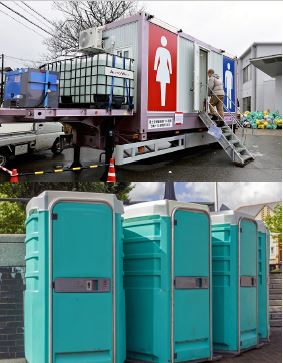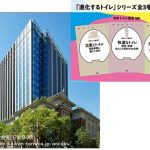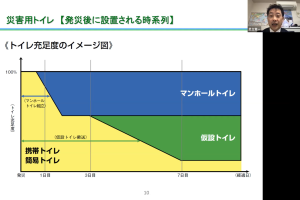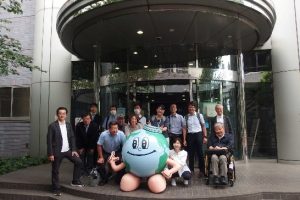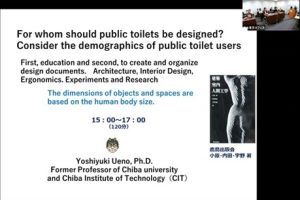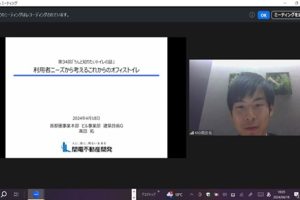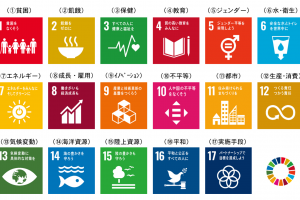The Noto Peninsula Earthquake Experienced by a Wheelchair User” The 45th JTA seminar “Let us know more about our Toilet Story”
Moderator Speakers
- <Moderator>Mikiko Takahashi,Ph.D. Director of JTA, Manager of R&D Division of Company Inc
- <Speakers1>Ikuo Matsuda (President, Ishikawa Prefecture Federation of Parents’ Associations for Children and Persons with Physical Disabilities),
- <Speakers2>Kimie Sakashita and Mayumi Kumano (Wajima City Parents’ Association for Children and Persons with Physical Disabilities)
Overview
(Takahashi) (Moderator)
I would like to begin the 45th session of “Let us know more about our Toilet Story.”
Today’s topic is the Noto Peninsula Earthquake as experienced by wheelchair users. We will hear from Mr. Matsuda, President of the Ishikawa Prefecture Federation of Parents’ Associations for Children and Persons with Physical Disabilities, as well as from Ms. Sakashita and Ms. Kumano of the Wajima City Parents’ Association for Children and Persons with Physical Disabilities, who experienced the earthquake firsthand in Wajima City.
On January 1st of last year at 4:10 p.m., a 7.0 magnitude earthquake struck. The earthquake claimed the lives of 562 people, of which 334 were disaster-related deaths. Two people are still missing. In the Noto region, following the earthquake, a major flood also occurred in September, resulting in 16 more deaths. All designated evacuation centers were finally closed on April 13th of this year. However, in some areas, there is still no clear prospect for infrastructure restoration.
(Matsuda)
Thank you all for joining us today to listen to our stories. My name is Matsuda, and I serve as the President of the Ishikawa Prefecture Federation of Parents’ Associations for Children and Persons with Physical Disabilities.
Today, we are joined by Ms. Sakashita and Ms. Kumano from the Wajima City Parents’ Association.
I was born in Suzu City, and I have relatives still living at my family home there. Even for able-bodied individuals, the toilet situation at evacuation shelters was extremely difficult. For people with disabilities who use wheelchairs, the situation was so severe that they simply could not stay in the shelters.
There were requests to relocate only the children with disabilities to medical facilities in Kanazawa, and I helped coordinate and support that process.
The epicenter of the Noto Peninsula Earthquake was in Suzu City, and it was a powerful earthquake with a maximum seismic intensity of 7.
Ms. Sakashita’s home was moderately damaged, while Ms. Kumano’s house was completely destroyed. Both of them are now living in Deemed temporary housing near Kanazawa City. (Deemed Temporary Housing: A system in which vacant private rental properties are leased and temporarily provided as housing to disaster victims in cases where there is a shortage of temporary housing.)
However, since Ms. Sakashita’s husband and Ms. Kumano herself are both Wajima lacquerware artisans, they travel to Wajima during the middle of the week for work and return on weekends to spend time with their children.
More than 100,000 homes were damaged, with approximately 25,000 of them either completely or partially destroyed.
In terms of infrastructure, the Noto Satoyama Kaido — the only major road in the area — was severely damaged. In the early days after the earthquake, the road was uplifted or collapsed in places, preventing even emergency vehicles from getting through.
Many people were forced to live in evacuation shelters. A secondary evacuation center (often referred to as a “1.5-evacuation shelter”) was set up at the Ishikawa Sports Center, but initially, many residents were reluctant to leave their hometowns.
(Takahashi)
Could you tell us about your family structure, Ms. Kumano?
(Kumano)
We lived about a 10-minute walk from the Wajima Asaichi (“morning market”) Street.
Our family consists of four members: the son in question, myself, my mother, and his younger brother. He is a man in his 30s with physical disabilities, holding a Type 1, Grade 1 disability certificate, and he also has an intellectual disability.
He used to attend a welfare facility located about 30 minutes from Wajima. At home, he moved around by crawling, and when going outside, he used a wheelchair or a walker.
(Takahashi)
How did he usually use the toilet before the earthquake occurred?
(Kumano)
At home, we installed handrails at a height that was easy for him to use while crawling, so he was able to go to the toilet by himself.
Although we monitored him because it was risky, he was able to go on his own. At the end, we would help wipe him a little and assist with grooming.
At the workshop, he used a walker instead of crawling, with a caregiver by his side, but he would go whenever he wanted to on his own.
(Takahashi)
The earthquake occurred on New Year’s Day, but what were the circumstances when you experienced it?
(Kumano)
On New Year’s Day, the four of us were gathered. Since my son likes driving, he wanted to go for a short drive of about 30 minutes, so we set out. About 10 minutes into the drive, the earthquake struck.
My phone alert went off, and when I stopped on a wide roadside shoulder, the main shock hit, and the car almost flipped over.
I saw a house collapse right in front of me and the landslide flowing down.
Everyone had fastened seatbelts, so we were safe, but the phone I was holding flew back into the trunk.
When we tried to return home, both sides of the road were blocked by landslides, and local residents were saying, “This way is blocked, and that way too.”
There were stones and rocks blocking a tunnel that we had passed just five minutes earlier. If we had been three or four minutes later, we might have been caught in the landslide.
(Takahashi)
How did you spend the first night?
(Kumano)
We were near the old Noto Mitsui Town Station in Mitsui Town, Wajima City, where there was no cell phone signal at all.
We hadn’t brought my child’s wheelchair or any drinks and kept turning the engine on and off until around midnight.
Some locals opened the community center and offered to turn on the stove, inviting us in. The men carried him carefully over the uneven ground and brought him inside.
By chance, the Red Cross had stocked mats and sleeping kits, which the locals distributed to us.
The aftershocks continued, so we couldn’t sleep, and from the window, the sky over Wajima was deep red. I heard on the radio that a fire had broken out in Wajima City.
The locals were very kind. When my mother was lying down, someone brought her a blanket and shared osechi (New Year’s) food with us all to eat together.
Everyone stayed with us, and their support was truly a help. It might have been the neighbors who managed the community center.
On the first night, my son and I curled up together on the floor wrapped in blankets, and every time it shook, I said, “It’s going to be okay.”
(Takahashi)
Could you tell me about the toilets at the community center?
(Kumano)
On the night of the 1st, there were about four or five cardboard portable toilets lined up. The portable toilets were inside the women’s restroom, but they were placed outside the individual cubicles, so we could see each other’s faces while using them. The disposable bags used with the portable toilets were not discarded after one use but reused by several people.
The hallway in the shelter had puddles from melted snow, and since my son didn’t have a wheelchair or walker, crawling through the puddles to get to the toilet would get him soaking wet. So I borrowed a plastic bag and, when no one was around, I would guard him in a corner of the hallway while he peed, then I would dispose of it in the toilet.
(Takahashi)
Privacy was important even for men, wasn’t it?
(Kumano)
Since it was late at night, I guarded him in a corner of the hallway, waiting until no one was around, and said “It’s okay” so he could do.
Although it was an unfamiliar and slightly shocking situation for him, he managed to stay calm and get through the night.
(Takahashi)
Did you try to return home the next day?
(Kumano)
A trip that normally takes 10 minutes took 2 to 3 hours. The roads were very congested and it took a long time.
Our house was completely destroyed. We had planned to eat osechi (New Year’s food) together, but the older part of the house was flattened.
If my son hadn’t said, “I want to go for a drive,” the four of us would have been in that room, so it really was a stroke of luck amidst misfortune.
That’s exactly what I thought when I saw the collapsed house.
There was an elementary school in front of our house that was also a shelter, but the corridors of the evacuation shelter were narrow, making it difficult to use the toilets or move around.
An acquaintance said, “Our house is destroyed too, but there’s a room, so come stay,” and we stayed there for about three days.
They said we could stay as long as we needed and even prepared warm meals for us.
(Takahashi)
How was the toilet situation at your acquaintance’s home?
(Kumano)
They fetched water from the mountain and poured it roughly with a bucket to flush the toilet. It didn’t flush if poured slowly, but after pouring vigorously about five times, it worked.
Since there were no handrails, I and my younger son held his legs to help him sit.
Three days later, the area was declared a landslide danger zone, and everyone evacuated with only the clothes on their backs.
Mr. Sakashita told us that the Fureai Health Center was somewhat available, so around January 4th or 5th, we evacuated there together.
(Takahashi)
How was the toilet situation at the health center?
(Kumano)
We were able to borrow one wheelchair on the first floor. We evacuated to the same floor as elderly people with limited mobility.
When taking my son to the wheelchair-accessible toilet, I was suffering from rheumatism and had difficulty using my hands, so I was unable to assist him properly. When he needed to defecate, he had help from others, and for urination, he went at the end of the hallway, hidden by a blanket, using a plastic bag.
My son was having difficulty defecating, probably due to stress.
(Takahashi)
What happened after that?
(Kumano)
We stayed only one night at the health center, then after consulting, we moved to a group home in Anamizu Town. Normally it’s about a 30-minute trip, but this time it took five hours.
At that time, my younger son developed COVID-19, and my mother also got infected, so we isolated them in two separate rooms and stayed there for about one week to ten days.
Sitting for a week caused my son’s leg muscles to weaken, making it difficult for him to get up to sit in his wheelchair.
After that, we moved to a “1.5 evacuation shelter,” the sports center, and then a “second evacuation” hotel.
We were finally able to bathe at a hotel in Kanazawa in late January.
There was a bath provided by the Self-Defense Forces, but it was impossible to use with a wheelchair. There was also a strict time limit of 15 minutes for bathing, and the baths were separated by gender, so it wasn’t possible to use.
Now we live in deemed temporary housing in Kanazawa, and my son goes to a welfare facility there. I work in Wajima on weekdays and spend weekends with my family.
My son asks, “Why can’t we go back to Wajima?” but I can’t give him a clear answer.
The neighborhood is now less than half of what it was, and I think every day about what to do.
The current deemed temporary housing is a rental, so we can’t install handrails in the toilet. Portable handrails take up too much space and make assistance difficult. Two adults help him to sit down.
(Takahashi)
Could you tell me about your family structure, Ms. Sakashita?
(Sakashita)
It’s just the three of us—my husband, my daughter, and me. My daughter uses a wheelchair and a walker.
My mother, who is 89 years old and requires care level 3, lives about one kilometer away. My younger brother and I took turns visiting her every day.
When my daughter started elementary school, we made the entire first floor of our house accessible .
We had experienced an earthquake with a seismic intensity of upper 5 before, as well as power outages and water outages, so we had prepared water and bottled water.
If the car had been in a garage with a shutter, I don’t think we would have been able to get it out.
(Takahashi)
What happened during the earthquake?
(Sakashita)
I was preparing dinner early. My daughter was holding onto the table standing up and was about to sit in her chair when the earthquake hit.
Since my daughter can’t get under the table by herself, my husband and I helped her get under it.
She was so shocked that her body stiffened and straightened out, so I covered her with my body.
I was apparently shouting, but all I remember is the rumbling sound.
Because it was the kitchen, dishes were scattered, but in my daughter’s room, we didn’t keep anything tall, and everything was secured, so it was safe. All the furniture on the second floor had fallen over.
(Takahashi)
Where did you evacuate to?
(Sakashita)
After checking on my mother’s condition, we evacuated to the Fureai Health Center. The roads were cracked, subsided, and bridges had risen, making travel difficult.
Some young people helped carry my daughter in her wheelchair up to the second floor.
The Asaichi (“morning market”) street was burning, so I was worried about acquaintances’ safety.
(Takahashi)
How were the toilets at the health center?
(Sakashita)
There was no running water, so the younger people carried water in buckets to flush the toilets. Eventually, we ran out of water, so I was taught how to use portable toilets and then I explained it to the next person.
Of the three women’s toilets on the second floor, two were broken. Only one women’s toilet and one multi-functional toilet were available.
Because the usable toilets were limited and crowded, and my daughter’s toilet use took time, she went when there were as few people as possible.
The layout of the handrails in the evacuation center toilets was different from our home, and although at home my daughter only needed to be watched over, here she required assistance.
The passages in the evacuation center were narrow, so when moving the wheelchair, we would say “Excuse me” as we passed.
For food, people who had homes near the shelter would walk back and bring food, so we managed somehow, but the toilet situation was tough.
As of January 7, temporary toilets had arrived at the shelter, but none were wheelchair-accessible.
My daughter has a house dust allergy and dietary restrictions.
I have an alcohol allergy and had an allergic reaction requiring emergency transport, but it wasn’t serious and I was able to return to the shelter.
When I was taken by ambulance, I thought it might be the last time I would see my daughter.
On the morning of the 7th, I left my daughter at a hospital in Kanazawa.
She had been growing her hair out, but I borrowed scissors and cut it and she was able to take a shower.
After leaving my daughter, I stayed at roadside stations, internet cafes, and relatives’ homes while looking for a group home for my mother.
Evacuation life continued, and since norovirus began spreading, we couldn’t return to the Fureai Health Center. After moving around for about a month, we found a group home for my mother.
(Matsuda)
To talk about the situation in the prefecture, damage to the Noto Satoyama Kaido made transporting necessary supplies difficult.
The D-MAT team started by cleaning toilets, highlighting how important hygiene was.
Challenges included a shortage of temporary toilets, not knowing how to use handy toilets, and securing wheelchair-accessible spaces for families.
To improve toilet conditions, creative solutions like using classrooms to create toilet chair spaces were necessary.
Holding in the need to use the toilet can increase the risk of disaster-related deaths.
There were also cases where sewage pipes were damaged at home, causing backflow in toilets.
The connections within the community were a major source of support.
As this earthquake occurred on New Year’s Day, many people had returned to their hometowns and were affected by the disaster, which made the situation particularly dire.
We were reminded again of the importance of prior stockpiling and drills.
Right after the earthquake, when I asked Ms. Sakashita what was most needed, she said, “We don’t have enough people.”
It seems that there weren’t enough staff just from the city to manage the evacuation centers and explain how to use handy toilets.
Community support and cooperation are extremely important.
(Takahashi)
Toward the end of the meeting, we emphasized the importance of self-help, mutual aid, and public assistance (7:2:1 ratio).
First, it is crucial to stock handy toilets yourself and actually practice using them.
